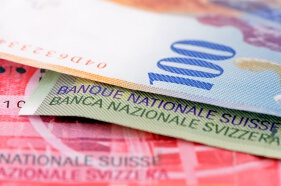The Swiss franc continues to strengthen against many of its major currency rivals. At the end of the trading week, the franc is looking to touch levels against the US dollar unseen in seven years, despite the Swiss National Bank (SNB)‘s myriad of foreign exchange interventions. How much more can the franc appreciate this year?
On Friday, the SNB announced that it recorded a $41.6 billion profit during the second quarter, as well as a $37.6 billion profit in its foreign currency positions during the April-to-June period. The central bank increased its stock and foreign currency at the height of the coronavirus pandemic after suffering a $41 billion loss in the first quarter.
Year-to-date, the SNB has recorded a profit of $880 million, primarily from valuation gains, dividends, and interest payments of its bond holdings.
All eyes will be on Switzerland when the US Treasury Department releases its semi-annual foreign exchange report. Analysts widely anticipate that Washington will name Switzerland as a currency manipulator as the SNB continues to intervene in forex markets and maintain subzero interest rates to limit the francâs appreciation.
SNB officials have signaled that they are not concerned about the possible designation, arguing that they are attempting to fight deflation and support economic growth. But the Official Monetary and Financial Institutions Forum (OMFIF), an independent forum for central banking, economic policy, and public investment, opined that the SNB could avoid this label by being more transparent about its measures.
In recent currency discussions with Korea, Vietnam, and China, Treasury pushed for more transparency to address harmful currency practices. Even though markets can largely discern Swiss intervention from weekly sight deposit data, the SNB publishes intervention data only once a year in its annual report. Switzerland is also highly transparent about the currency and investment breakdown of its foreign reserves. Nonetheless, an explicit monthly statement on intervention could further improve transparency.
Ultimately, however, the OMFIF does not believe the case for labeling the franc as a currency manipulator is convincing.
This week, a lot of economic data was published that still shows a struggling post-COVID-19 economy. The July Economic Sentiment Index came in at 42.4 â anything below 50 indicates a contraction. The KOF Leading Indicators Index surged to 85.7 in July, beating the market forecast of 75. Retail sales fell 3.8% last month, down from the 30.8% spike in May.
Next week, authorities will publish inflation, manufacturing, consumer confidence, and forex reserves data.
The USD/CHF currency pair rose 0.46% to 0.9131, from an opening of 0.9090, at 17:07 GMT on Friday. The EUR/CHF dipped 0.05% to 1.0765, from an opening of 1.0771.
If you have any questions, comments, or opinions regarding the Swiss Franc, feel free to post them using the commentary form below.
